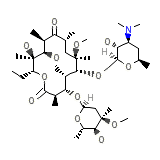CAM
Brand names,
CAM
Analogs
CAM
Brand Names Mixture
CAM
Chemical_Formula
C38H69NO13
CAM
RX_link
http://www.rxlist.com/cgi/generic/clarith.htm
CAM
fda sheet
CAM
msds (material safety sheet)
CAM
Synthesis Reference
Y. Watanabe et al.; U.S. Pat. 4,331803 (1982)
CAM
Molecular Weight
747.953 g/mol
CAM
Melting Point
217 - 220 oC
CAM
H2O Solubility
0.33 mg/L
CAM
State
Solid
CAM
LogP
2.69
CAM
Dosage Forms
Suspension (oral); Tablet; Granules (for oral suspension)
CAM
Indication
For the treatment of bacterial infection of (pharyngitis/tonsillitis, sinusitis, bronchitis, pneumonia, uncomplicated skin and skin structure infections) caused by H. influenzae, M. catarrhalis, M. pneumoniae, S. pneumoniae, C. pneumoniae (TWAR), S. aureus, S. pyogenes, Mycobacterium avium and Mycobacterium intracellulare
CAM
Pharmacology
Clarithromycin, a macrolide antibiotic similar to erythromycin and azithromycin, is effective against Mycobacterium avium complex (MAC) and is used for the treatment of Helicobacter pylori-associated peptic ulcer disease, community-acquired pneumonia, sinusitis, and chronic bronchitis. Clarithromycin is also used to treat respiratory tract, sexually transmitted, otitis media, and AIDS-related infections.
CAM
Absorption
50%
CAM
side effects and Toxicity
Symptoms of toxicity include diarrhea, nausea, abnormal taste, dyspepsia, and abdominal discomfort. Pseudomembraneous colitis has been reported with clarithromycin use, allergic reactions ranging from urticaria and mild skin eruptions to rare cases of anaphylaxis and Stevens-Johnson syndrome have occurred. Rare cases of severe hepatic dysfunctions also have been reported. Hepatic failure is usually reversible, but fatalities have been reported.
CAM
Patient Information
Clarithromycin is an antibiotic used to treat infections such as sinus infections, throat infections, tonsil
infections and other lung related infections. It can be used by some patients to prevent infections. It is important
that you take this medication for the full period of time your doctor has prescribed it, even if you feel better
after a day or two. This medication should not be taken by those with an allergy to erythromycin. There are several
significant drug interactions with clarithromycin. Make sure to have your doctor or pharmacist fully evaluate all
medications you might be taking and ask them about drug interactions. The most common side effects reported include
taste disturbances, diarrhea and nausea, occurring in approximately 3% of patients. Clarithromycin can be taken with
or without food. Unlike other suspensions (liquid forms), this suspension should not be refrigerated.
CAM
Organisms Affected
Enteric bacteria and other eubacteria


















